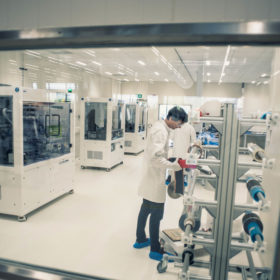
Solid-state batteries are viewed by many as the most promising technology to succeed lithium-ion in many energy storage applications. But there are still plenty of barriers to large-scale use of this type of battery. An international team of scientists has reviewed recent progress with the technology, and examined the form and chemistry that commercial solid-state batteries might take.
Whether degradation and performance loss, reliance on expensive materials or risk of fire, today’s lithium-ion battery technologies come with a host of areas to improve on.
Solid-state batteries potentially tick all of these boxes and could offer much higher density at the same time. And the technology has certainly grabbed the energy industry’s attention, with major battery players such as CATL, Ganfeng Lithium, Samsung and Mercedes working to develop solid-state battery concepts for various applications.
In a new paper, Designing solid-state electrolytes for safe, energy-dense batteries – published in Nature Reviews: Materials – scientists from Cornell University and China’s Tsinghua University review recent progress with various iterations of solid-state technology and the challenges still remaining for the production of practical solid-state batteries of any chemistry.
New challenges
The group notes that while dendrite formation at the lithium-metal anode has historically been one of the biggest hurdles, recent developments have proved reliable in avoiding this, allowing researchers to focus on other areas.
“Advances have, to an extent, moved the spotlight from the Li-metal dendrite problem and instead focused attention on other requirements for solid-state electrolytes,” the scientists said. “These include decreasing the cost and weight, and increasing the efficiency of interfacial ion transport, environmental stability and long-term chemical, structural and mechanical stability when in contact with active electrode materials.”
Since there is a wide range of possible materials with the potential for use in a solid-state battery, understanding the interactions between them will be key to their development.
“Through comprehensive considerations of chemical, geometric, mechanical, electrochemical and interfacial transport features, more advanced solid-state energy-storage or energy-conversion systems can be expected in the future,” the group concluded.
Lắp đặt điện mặt trời Khải Minh Tech
https://ift.tt/2X7bF6x
0906633505
info.khaiminhtech@gmail.com
80/39 Trần Quang Diệu, Phường 14, Quận 3
Lắp đặt điện mặt trời Khải Minh Tech
https://ift.tt/2ZH4TRU
Không có nhận xét nào:
Đăng nhận xét